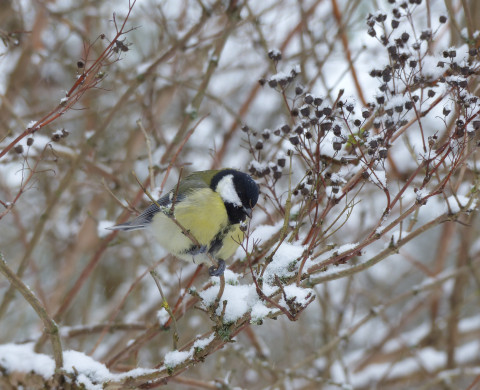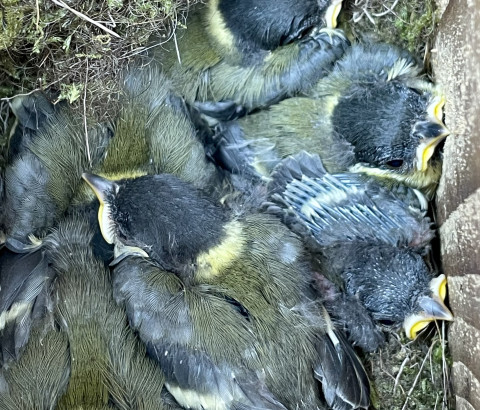Seasonal timing

As a result of climate change, spring arrives earlier and summer lasts longer than used to be the case in our part of the world. Many annually recurring events in nature are therefore starting earlier or have a longer seasonal duration. However, some species adapt at a different rate than others, which means that interactions between species can also change. Researchers from the Netherlands Institute of Ecology (NIOO) studied the consequences of those differences in shifting seasonal timing.
Temperature and day length
Marcel Visser is an animal ecologist at NIOO. “Because of rising temperatures, plants flower earlier in spring, insects emerge from hibernation sooner, and birds migrate back from their wintering areas earlier and lay their eggs earlier. ‘But besides temperature, day length is another important factor for many bird species and for mammals too. And climate change has no effect on that, of course.”
Visser is doing research into coal tits and their prey: the caterpillars of winter moths. “Young coal tits grow from 1 to 18 grammes in 18 days, and coal tits often have a nest with up to nine fledglings”, says Visser. To feed those fledglings, the coal tits depend on a period in spring when winter moth caterpillars abound. However, this period now occurs increasingly earlier and the young coal tits do not hatch early enough to benefit from the caterpillar peak.”
Genetic characteristics?
Visser carries out experimental research on genetic adaptation in coal tits to determine whether they are able to keep up with the seasonal timing of their prey. “The question that needs answering is to what extent a characteristic is heritable? It is known that female coal tits that lay their eggs early in spring get daughters that also lay early. As these females have an advantage compared to the birds that lay their eggs later, there is a selective advantage for females with that characteristic. But despite that, the genetic adaptation of the coal tit is not spreading fast enough to keep up with the current rate of climate change. In this way, climate change leads to ecological relationship problems.”
Climate change leads to ecological relationship problems
More generations each year
Guest researcher Jeff Harvey is a specialist in the ecology of insects and spiders. He already observes problems at the base of the food chain due to changes in seasonal timing. Just as birds can be too late for their prey, insects can be too early for their food. For example, the cabbage moth is a migratory butterfly that, in the past, only arrived in the Netherlands in the summer after wintering in southern Europe. Harvey explains that this species began to survive Dutch winters in the early 1990s. “Consequently, they are present in the Netherlands far earlier in the season. At times, caterpillars hatch out of their eggs so early that there are no plants available yet for them to eat. That fact alone influences the food chain for birds and other vertebrates.”
Early algae and bacteria, but zooplankton lag behind
Lisette de Senerpont Domis and Dedmer van de Waal from the Department of Aquatic Ecology observe that the relationships between aquatic species are changing in a similar manner to those between birds and insects. De Senerpont Domis: “When algae and bacteria peak earlier in spring due to rising temperatures, zooplankton are still hibernating, as a result of which they arrive at the party too late and miss their meal. In the food chain, that can exert an influence right through to the level of fish.”
A species risks arriving at the party too early or too late.
Temperature changes in winter can influence algal bloom in spring as well. “In years with warm winters, diatoms are suppressed by a parasitic fungus. Whereas at cold temperatures, the fungus is not able to infect the diatom properly”, explains De Senerpont Domis. “This means that after a winter with higher temperatures, the algae do not bloom, which could have consequences for zooplankton in the spring.”
Simulating a warm spring
Van de Waal and De Senerpont Domis carry out experiments in so-called mesocosms: large-scale systems that simulate lakes. These experiments with increased temperatures in spring yielded surprising results. Van de Waal: “That is the moment when zooplankton come out of hibernation. Their food, the algae, was suppressed by fungi. However, we discovered that zooplankton can survive on the spores of those fungi because they are also highly nutritious.” This reveals that shifts due to changes in temperature for one species or group can have consequences for the entire system. Furthermore, these effects can be observed across seasons.
A longer season
As a result of climate change, spring not only arrives earlier but the growth and flowering season lasts longer too. De Senerpont Domis sees that at the micro level through to high up in the food chain: “Cyanobacteria - blue algae - now bloom into the autumn and waterfowl that live on the Markermeer in summer, stay in the Netherlands longer because the blue algae restaurant remains open longer.”
At the end of the season, the weather can suddenly turn too cold.
Due to the lengthening season, insects can remain alive longer than is good for them, says insect expert Harvey. “Insects now have more generations in a year than was previously the case. Instead of one generation a year, sometimes as many as three or four generations come into being each year. As a result, when the weather suddenly turns much colder at the end of the season, there is always the risk that adult insects die without proper preparations for winter.”
Experts
-
Marcel E. Visser
Head of department , Animal Ecology
-
Joseph Burant
Tenure Track , Animal Ecology
-
Lisette de Senerpont Domis
Senior Researcher , AKWA (Aquatic Knowledge Centre Wageningen) | Aquatic Ecology
-
Dedmer Van de Waal
Senior Researcher , Aquatic Ecology
Applications
- Nature policies
- Climate policies
- Nature management & conservation





